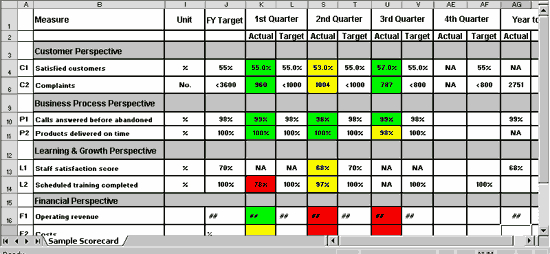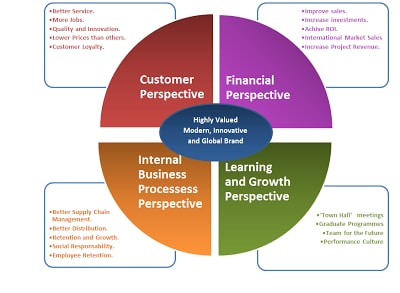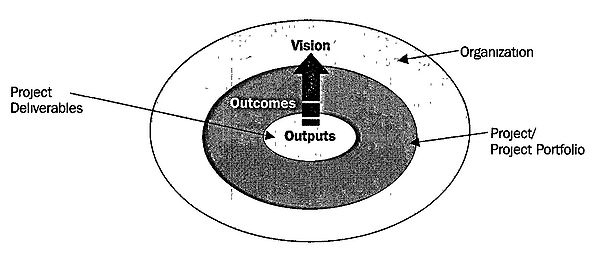Balanced scorecard in project management
Developed by Riccardo Ferranti
The balanced scorecard approach was proposed for the first time by Robert S. Kaplan in 1992 in the article “The Balanced Scorecard – Measures that drive performance”, published in the Harvard Business Review.
The balanced scorecard is a strategic planning and management system broadly used in many types of organizations to align business activities to the vision and strategy of the organization, improve internal and external communications, and monitor organization performance against strategic goals [1]. The new idea claimed that an exclusive financial approach to measure the performance was not enough to have a complete idea of the business, or to reveal the business areas afflicted with problems and to point out areas for improvement. A project, in fact, has numerous aspects and an organization cannot afford not to consider all of them when evaluating the aforementioned project. Evaluating these aspects separately would likely lead to a sub-optimization of one or more aspects, and consequently would make the organization miss its long-term objectives.
For these reasons, the balanced scorecard (BSC) involves four key business aspects: financial perspective, customer perspective, internal business perspective, learning and growing perspective, each providing an overall view on all the organization through measurable goals and outcomes. What makes the notable, positive difference between this approach and other existing tools is that all the needed measurements are presented in a single report: this clarity is exactly what avoids the sub-optimization and guarantees the pursuit of the entire organization’s interests. [2]
Contents |
The balanced scorecard approach
“A project is a unique process consisting of a set of coordinated and controlled activities with start and finish dates, undertaken to achieve an objective conforming to specific requirements including constraints of time, cost and resources.” [3]
The definition of project, as provided by ISO 10006:2003, highlights how a project is made up of processes and procedures which involve a large set of activities and tasks that need to be organized and controlled through a precise method. However, every project can be characterized by three fundamental aspects that deeply change the approach to project management:
- Complexity. Many activities and individuals are involved in the development of a project and the interactions between them strongly effect and, in turn, complicate their tasks.
- Unpredictability. No matter how accurate the planning of a process may be, many times the results are do not yield what is expected. This creates another layer of complexity.
- Ambiguity. Due to the complexity and unpredictability, it is difficult to understand what is actually occurring during the development of a project. Hence, in order to understand the actual situation, it is paramount to pay particular attention all the indicators that provide the greatest value. [4]
In a similar context, it is clear that the balanced scorecard helps to clarify the vision of the whole organization, providing information about all areas of business, without sub-optimizing only one of them.
Since projects can be considered “mini organizations”, each requiring a strong control of the current situation, the BSC is a powerful tool for project management, providing continuous checks throughout the project life cycle.
All projects are built around some key business objectives: high productivity, high quality, on time delivery, growth of market share, utilizing resources effectively and efficiently. However, in the BSC approach, project managers are required to choose and customize those indicators that better fit the specific needs of that project. When a project manager takes into account all of the four perspectives that characterized the project, he will start to understand what activities can have a better influence on the project and what impacts it can have on the entire organization.
The objectives of the balanced scorecard approach are to:
- Ensure that measures support the organization’s core values;
- Choose efficient, effective and meaningful performance indicators to check project health throughout the project life cycle;
- Align the measures against the project’s charter; [5]
In order to obtain an easier and faster impact for the reader, the BSC models use the “stoplight” color scheme (figure 1).In this way, it visually captures the reader’s attention to the areas that mainly deserve corrective activities and decisions.
It uses the green color, if the measured performances follow what was decided in the planning phase of the project and if it is aligned with stakeholders’ expectations. The yellow color is used if some little deficiencies are shown, and the red color if some serious deficiencies have been detected. Furthermore, the information provided with the colors are supported by numerical data showing a percentage of health of the project with respect to what was planned.
In the case of green color, no further actions are required.
In the case of yellow color, the report wants to give an alarm in order to signal that some aspects have to be monitored and some action may be necessary in the near future.
In the case of red color, the project manager is told that worrisome problems have been found and the project can be in jeopardy. Sudden actions are to be implemented and a special attention is to be given to those factors involved in those indicators.
The four perspectives
[6] As previously stated, in order to supply a complete view of the project’s situation, besides the traditional financial indicators, the balanced scorecard involves three other key business aspects, each one showing a particular side of the organization through measurable goals and outcomes. The four perspectives provided by the BSC approach are:1- Financial perspective: evaluates the financial situation exploiting the traditional economic indicators (such as revenue growth, profit growth, etc.).
2- Customer perspective: evaluates how current and future customers look at the organization, through particular indicators that may be customer retention, customer satisfaction, market share, etc.
3- Internal business process perspective: evaluates the health of the activities and processes occurring inside the organization by means of practical indicators (cycle time, speed of services, etc.).
4- Learning and growing perspective: evaluates how the organization supports and encourages those activities that create innovation and growth in both processes and individuals involved. Some useful indicators for this perspective may be effectiveness of change to technology and processes, speed and frequency of changes, etc.
The financial perspective
The financial perspective deal with the cons takes into account the perspective of the stakeholders of the project. The main aspect to be investigated is the revenue gained from the outcome. A project should bring as much value as possible to the organization and, thus, the indicators involved in this perspective should reflect profitability and growth and show whether the project follow the organization’s overall strategy. The financial perspective may look the most important, but it is paramount to highlight how it is often the result of what the management do to handle the other ones.
The customer perspective
[7] The customer perspective must take into consideration the market value of the project derivable as well as stakeholders’ satisfaction. It highlights that the project is managed in a global environment and that its aim is not satisfy the project’s sponsor, but rather to satisfy the customers’ need. The customer view reflects the level of service and quality provided by the organization as well as the resulting cost. Hence, the main point in this perspective is the alignment between the project outcomes and the customer’s expectation that is not always easy to get.
According to a customer satisfaction survey by The Marketing Science Institute of Cambridge, Massachussets (Smart Workplace Practices, 1996), customers’ expectations include the following characteristics:
- Reliability. Customers ask that the project be dependable and consistent and demand promises to be kept.
- Responsiveness. Continuous communication as well as a fast delivery is often a key aspect in order to manage a cooperative project.
- Assurance. Confidence between organization and customer is paramount to achieve the best results.
- Empathy. Customers really care about how they are treated and this often implies understanding beyond the contractual arrangements. Dealing with the customers as a partner or team member really help to build a durable and consistent relationship between the members of the project. [8]
Indifference often causes customers to look for another vendor who may offer a better treatment. Some surveys demonstrate that unhappy customers tend to tell an average of 12 people the problems they had with that particular vendor. [9] It is clear how this problem has repercussions on a very great scale, making the company face bigger problems and losses as a result of indifference and lack of empathy.
The internal business process perspective
The goal of the internal process perspective is to evaluate anything that can influence the development of the project, the products and the services offered. It is important here to create maps of every process and activity involved in the project, as well as support a continuous improvement process. It involves all the core competencies of the project team members as well as the factors that determine the project life cycle. The question that the organization has to ask itself is “At what do we need to excel?”, in order to find out the most important areas where the project manager has to concentrate to achieve the best results for the project and for the whole organization. The content of this perspective incorporates what has been decided during the planning phase of the project, in order to allow the managers to evaluate timeliness, performance and costs resulting in the project life cycle.
The learning and growing perspective
The modern business environment changes very suddenly and the organization must continually evolve in what it offers to keep the pace. In the same way projects, especially long-lasting ones, have to continually analyze the environment in which they work, in order to be sure that the condition and basis used to build the planning phase are not changed.
During the development of the project, the team members have to be innovative and learn new ways of doing their tasks and approaching the problems they will face. The ability of growing throughout the life cycle reflects the organization’s expertise. Working in a project is supposed to provide the possibility of an individual and personal improvement as well as an occasion to bring a positive impact in the whole organization. When this perspective is analyzed, it is important to use indicators that show the commitment in a long-run view, and to support the work with as many as possible tools for conserving and transmitting the knowledge obtained during the project.
Procedure of construction of the balanced scorecard
[6] As in every management tool, the application of the BSC requires that the project management team follow a procedure made up in four fundamental phases:
• the initiation phase, in which the managers have to establish the link between the organization’s vision and the project vision;
• the planning phase, in which a clear plan has to be created, taking into account risks and communication management;
• the execution phase, during which it is required a continuous process of monitoring and control to fit the changes due to not expected results;
• the closing phase, in which documents and reports are created, in order to conserve the “lessons learned” during the project and to develop the organization’s best practice.
Initiation
[6] [10] Every project stems from an identified problem within an organization, such as a technological requirement, a business reengineering need, or financial issues. Every problem should be treated in a different way and will require different methods and approaches; thus, it is important to define the final strategic objectives of the project that have to be a link between the organization’s vision and the project’s expected outcomes and have to involve all the four different perspectives that form the balanced scorecard.It may often be that one perspective is the focal point of the project and the most of the objectives deal with that view, but it should not take precedence over the remaining perspectives. It is always important to have a complete view of the overall situation.
Since the daily routine of managing a project often distracts the team from the long-term objectives, clear communication as well as clear goals is fundamental in order to avoid only reaching the short-term benefits, as these situations that may cause the initial outcomes to be missed.
In order to define the project’s objectives, the SWOT matrix can be used to show the Strength, the Weaknesses, the Opportunities and the Threat of the project, both from an internal and external point of view.
After having defined the objectives, it is required to choose the measurements that better explain the project’s aim and this is probably the most tough milestone of the approach, because choosing the wrong indicators will lead not to an actual overall view of the project. Although all the projects have the same main objectives (such as achieving high productivity, improving quality, delivering at the appropriate time, decreasing cycle time, growth of the market share, managing cost), each Balanced Scorecard must be customized to better fit the needs and the aims of the project in which it is used, that mean choosing the appropriate Critical Success Factors (CSF).
The CSF can be defined as “the critical areas or aspects in which the achievement of excellent results implicates success” both for the projects and for the organization.
In order to get the process of choice easier, it can be useful start from a classification of CSF (provided by Bracchi et al., 2001):- Critical Success Factors concerning with the specific industry: each industry has its own main factors that influence the business;
- Critical Success Factors concerning the competitive environment in which the company works: depending on the way the company acts in the market there will be different primary factors to consider (for example a company may use a cost leadership strategy or a quality leadership strategy);
- Critical Success Factors concerning with external restriction: for example environmental laws that influence the development of a project, shortage and criticality of some particular raw materials;
- Critical Success Factors concerning with temporal factors: it is important to remember that during the life cycle of a project the condition of both the company and the environment may change and the CSF require a periodic check and revision. [11]
After the analysis of the areas involved in this classification, it is possible to increase the detail level and define, exploiting the knowledges of most expert managers working at the project, which particular indicators may be choose for the current situation, taking into account that is recommended do not go over the twenty indicators. If more than twenty measurements are used, the effort required to manage them becomes too great and the project team will often begin to believe that the measurement process does not give a positive influence to their work.
Some very common example of measurements are the following:
- Financial: variance from the original decided budget, costs as compared to industry standard, earned value;
- Customer: customer satisfaction, project meeting intended objectives;
- Internal processes: resource requirements management, project backlog, risk management statistics, quality management statistics;
- Growth and learning: best practice identified, lessons learned and applied, development of tools and procedures;
The initiation phase has to define the gap between where the organization is today and where it wants to be at end of the project, and in order to do that, it is necessary to also define the target of the project manager.
Planning
The planning phase is always critical, because “failing to plan is planning to fail” [12]. In this phase, the project managers have to decide which initiatives they want to adapt in order to gain the arranged objectives. This means stating what is to be done, who will do it, when it will be done, and what resources are needed. It is dependent on the type of project and the type of environment in which the organization works, but in order to manage these issues is always fundamental a great understanding of the project objectives, of the project team member and of the project stakeholders. This is the only way to build strong basis for the project.
Today’s environment is very hectic and a static approach is no longer enough in order to succeed. Nowadays, it is required to reevaluate periodically the situation, analyzing both the current and previous phase of the project. For these reasons, during the planning phase the main focus of project managers should be risk and change management and a clear and fast communication plan should be established. Problems will undoubtedly occur and the organization should be as best as possible ready to manage them.
Execution
During the execution phase, the planning phase output is implemented. The progress is confronted with benchmarks and the evolution of the project is evaluated. Problems with financial, customer, operational or growth areas are identified and analyzed to find out the root-cause and improve the overall performances. Furthermore, the changes in environment and in customer’s needs make the project manager adapt to the new situations and the risk and change management plan, established in the planning phase, is implemented.
Monitoring and controlling play a paramount role in this phase. Every project should adapt a proactive approach to the resolution of reoccurring weaknesses, instead of adapting a reactive approach that makes organization manage projects “by crisis”. Many project teams ignore the importance of quality assurance, pointing to it as “lack of time”, but this always results in poor quality and lack of improvement in the long-run. When one of the perspectives is not satisfied, the whole project goes in crisis.
Closing
The closing is the final phase. When a project has been completed, it is important to gather and review all the documentation and create a final closeout report of the project. This allows for all of the lessons learned to be synthesized in their entirety for future use and help in the development of the organization’s “best practice”. All this information is published to the organization’s knowledge base in order to develop the expertise of every manager inside the company and it will be very useful for the next similar projects.
Limitations
Kaplan and Norton indicated the most common failure causes as:
- Lack of commitment from senior managers;
- Too few people involved in the project;
- Use of the BSC approach only at higher level of the company;
- Using the BSC very seldom, as an one-time instrument.
One of the most common obstacles for the application of the balanced scorecard approach is that it requires a wide use of financial and temporal resources, and, even when it has been prepared, it requires a lot of resources for its maintenance.
Another limitation is posed by the choice of the Critical Success Factors, in particular of the non-financial ones. It is often difficult to transfer objectives and strategies in indicators that are supposed to explain the evolution of a project and this may lead to a misrepresented view of the project status. Consequently, it is quite clear how the application of the balanced scorecard approach require a strong integration between data from the accounting system and data from other sources.
Hence, it is clear that the balanced scorecard approach is a powerful tool for project management. Since it provides a comprehensive view of all the sides and stakeholders involved, yet requires a deep understanding of its use, from the senior management to all the employees that work on the project, it alters the mentality of the entire organization via its total clarity and effectiveness. Its application must be assimilated as the primary method for managing, not simply a tool to use occasionally. [13]
References
- ↑ Robert S. Kaplan and David P. Norton, “Using the Balanced Scorecard as a Strategic Management System,” Harvard Business Review (January-February 1996)
- ↑ N. Slack, A. Brandon-Jones, R. Johnston, A. Betts, “Operations and process management – Principle and practice for strategic impact”
- ↑ ISO 10006:2003, Quality Management Systems – Guidelines for Quality Manage
- ↑ Lee G. Bolman, Terrence E. Deal, “Reframing organizations”
- ↑ J. Furlonger, “Using balanced scorecard to measure project success”
- ↑ 6.0 6.1 6.2 Wendy E. Stuart, “Balanced scorecard for projects”
- ↑ Barret, Paul, “The high cost of losing customer”
- ↑ “Smart Workplace Practices”, by The Marketing Science Institute of Cambridge, Massachusset, 1996
- ↑ “Bizmonthly”, 1997
- ↑ Fabrizio Di Crosta (2005), “Indicatori di performance aziendali. Come definire gli obiettivi e misurare i risultati”
- ↑ Bracchi G. et al., “Sistemi informativi e aziende in rete”, McGraw-Hill, Milano, 2001
- ↑ “PMBOK® Guide”
- ↑ Manuel Bordignon (2008) “Il controllo di gestione. Strumenti, evoluzione, esigenze e potenzialità”
Annotated bibliography
- For further general information about the Balanced Scorecard approach, it is suggested: Kaplan, R. S. and Norton, D. P. (1996), “The Balanced Scorecard”, Harvard Business School Press or the website https://balancedscorecard.org/ .
The book is the original book written by Kaplan and Norton, the recognized architects of the Balanced Scorecard. Here the authors fully explain the Balanced Scorecard approach, from its birth to its construction and application. They also focus on the way the company has to create the global common view inside the team and the organization, in order to exploit this tool as its best, providing examples of application. The website is managed by the Balanced Scorecard Institute (BSI) and provides training, certification and consulting services about the BSC approach. It provides the basis of the tool, as well as articles about related topic such as strategic initiative management, strategy execution and performance measurement.
- For more information about the Critical Success Factors and the way to choose that, it is suggested: Boynton, A.C., and Zmud, R.W. 1984. "An Assessment of Critical Success Factors," Sloan Management Review (25:4), pp. 17-27 or Bullen, C.V. and Rockart, J.F. "A Primer on Critical Success Factors," Working Paper No. 69.
The first article analyzes the Critical Success Factors (CSF) method by presenting two case studies, focusing on the way it supports planning processes, helps to communicate information through the whole organization, and promotes a structured analysis of the processes. The second article explains the CSF firstly providing background information about it and then about their use. For instance, it gives the definitions of CSF, strategies and objectives, and also explains the nature of CSF, the differences that have to be taken into account in order to adapt their use to the different projects involved. The second part faces the techniques for the choice of the appropriated measurements and for the analysis of the gathered data.
- For more information about how to define organization’s strategies and goal, it is suggested:
A knowledge-based SWOT-analysis system as an instrument for strategic planning in small and medium sized enterprises, Decision Support Systems, Volume 26, Issue 2, Pages 125-135, G. Houben, K. Lenie, K. Vanhoof.
The article describes the use of the SWOT matrix, helping a company to analyze Strengths, Weaknesses, Opportunities and Threats of a project in order to improve the organization’s strategic management cycle. In particular, it focuses on the methods for the construction and the development of a knowledge-based SWOT-analysis system and then on the verification, validation and assessment activities requested.




